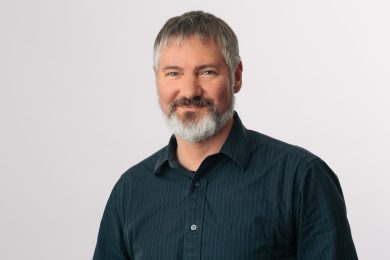For 45 years, The Music Gallery has played an influential part in Canada’s evolving experimental music scene, including the creation of its own label, Music Gallery Editions (1977-1981); launching MusicWorks magazine, now separately run; programming a series of “guerilla location” events around Toronto; and eventually, settling into its current home at 918 Bathurst St., a few blocks North of Bloor St. Today, the independent venue can add “programming through a pandemic” to that list.
For its new Artistic Director, Sanjeet Takhar, programming in the COVID era meant accepting its unpredictable nature from day one. “In the first year, I don’t think I was surviving!” says Takhar. “We basically had three plans for each event that we mapped out with each artist: a 50-percent-capacity performance, a livestream at the venue, or a pre-recorded performance. It was exhausting, and required navigating an ever-shifting calendar.”

David Dacks
David Dacks, the Music Gallery’s former decade-long Artistic Director, now Executive Director, commiserates, adding that watching the music community try to endure has been challenging. “A lot of artists have been taking stock of their lives, their practices, and other big questions,” says Dacks. “Some have left town; some haven’t felt motivated to make art, and struggle with mental health; others, especially now, have gotten sick. So plans have changed constantly.
“We’ve been fortunate to access COVID relief [including SOCAN Foundation support] and keep up a pretty good pace of programming in order to keep paying artists and arts workers, but the fact is that a pandemic is disruptive. We need to listen to our artists and audiences about what they need, now more than ever.”
One way that The Music Gallery gives artists what they need is by being Licensed to Play with SOCAN. “For songwriters or composers whose work we’re presenting, we make sure they’re credited and/or compensated with the help of SOCAN,” says Takhar. “To music creators that aren’t SOCAN members, and/or come from outside Canada, or are no longer alive, we look into clearing all rights, paying attention to use, and compensating their estate if relevant.”
Another way is by being open to change. “Probably the biggest change was when we stopped programming in musical genre-based streams,” says Dacks. “It was too problematic to divide complex artistic ideas into jazz, classical, pop or world music – ugh – streams. In doing so, we were able to take on and help foster unique projects such as David Virelles’ Afro-Cuban chamber jazz project Gnosis, which was later recorded and released on ECM Records, to worldwide acclaim…
“Another was including artists as curators of other events, which is something that’s been increasingly a part of our programming in recent years. The most prominent example was Bear Witness of the Halluci Nation [formerly A Tribe Called Red] programming our flagship X Avant Festival in 2018. He was able to try out programming ideas, and work on the ‘Halluci Nation’ concept further, including in a live-band format, which subsequently ended up touring and recording.”

Sanjeet Takhar
In spite of their new roles and unprecedented hurdles, Dacks and Takhar found working as a team a natural fit. “It was clear that Sanjeet was the best choice for Artistic Director,” says Dacks, recalling what made them stand out. “We chose them for their worldview, their empathy, their work ethic, their perspective on what experimentation in music could and does look like, and their attitude towards plugging into the Music Gallery’s history and community, while guiding it forward. Like me, they didn’t have an academic background in music to relate to that aspect of our history, but as a DJ, they have wide-ranging tastes and an innate disposition for programming.”
For Takhar, transitioning from independent artist to Artistic Director required much thought. “Moving from DIY to an arts institution made me really nervous,” they say. “With a massive political shift due to the murder of George Floyd, for months I witnessed IBPOC community members being consumed by institutions that weren’t ready for change. It led to harm, it led to them having to leave. Before accepting my role, I spent about two weeks consulting people with close relationships to the Music Gallery… While I expected the ‘same old story,’ it actually was a huge source of comfort. People praised the space, praised David Dacks, and told me of formative experiences they had participating in events there… It has such a strong foundation for social change, they’ve been working on inclusive policies and practices for years, not weeks.”
Takhar says that as The Music Gallery envisions its future, it’s keeping artists at the forefront: “We’re currently planning our 2022-23 programming year to adjust to these changing times. Programming into the future the same way we did in the past is like putting a square peg in a round hole. It just doesn’t make sense. We’re currently having in-depth conversations with our Board [of Directors], artists, advisory councils, and internally with staff, about new initiatives that will shift our perspective from a concert hall that is limited to livestreams, to a hub for experimentation, where artists can grow.”
Music for All: Sanjeet Takhar on making the Gallery more inclusive
- Money matters: “For development and for requested performances at the Music Gallery, review CARFAC (Canadian Artists’ Representation/Le Front des artistes canadiens) and musicians’ union rates to match or exceed them. If we’ve worked with artists before, we consider prior rates with inflation. Most importantly, we talk to artists. Money is a sticky subject in the arts, there is so much taboo around it. We try really hard to have candid conversations of what’s in our budget and how we can make something work. We ask artists what would make them feel comfortable and what would be representative of the work they put in.”
- Open calls for submissions: “To create equity for emerging artists and those who receive less government funding, we run open calls for submissions to present their work in our concert halls. We cover all fees, knowing the barrier to entry isn’t the same for all performers.”
- Invest in artists: “We invest in all of our artists. There’s always high-end photography, and in recent years, high end video footage to add to their portfolio.”